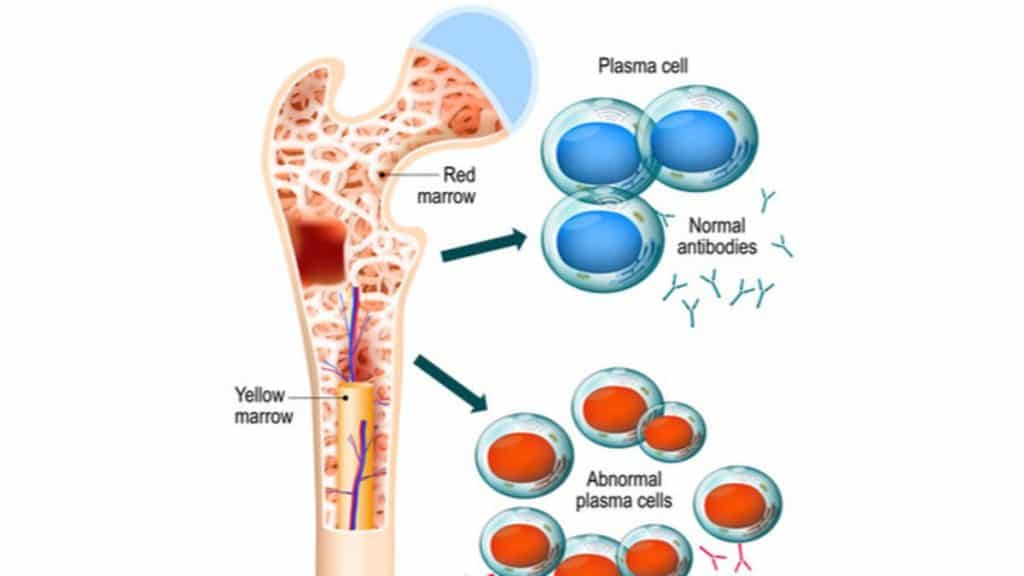Multiple myeloma is a cancer of the plasma cells, a type of blood cell that produces antibodies and serves an important immune function.
Multiple myeloma is also known as plasma cell myeloma and simple myeloma. As cancer progresses, bone pain, bleeding, frequent infections, and anemia may occur.
The cause of multiple myeloma is generally unknown, however predisposition factors include obesity, radiation, family history and certain chemicals.
Treatment for multiple myeloma isn’t always necessary for people who aren’t experiencing any signs or symptoms. For people with multiple myeloma who require treatment, several treatments are available to help control the disease.

Symptoms
The most common symptoms of multiple myeloma are:
- Bone pain – Bone pain affects almost 70% of people with multiple myeloma and is the most common symptom. Myeloma bone pain usually involves the spine and ribs and worsens with activity.
- Hypercalcemia (elevated calcium levels) – Hypercalcemia refers to a high calcium level in the blood serum. As bone is broken down from the lesions formed, there is a resultant high calcium level in the blood. This leads to hyperkalemia and its associated symptoms such as abdominal pain, depression, confusion, and body weakness.
- Anemia – Myeloma inhibits the production of red blood thereby leading to anemia in form of normocytic and normochromic anemia.
- Renal failure – Impaired kidney function may develop, either acutely or chronically, and with any degree of severity.
The most common cause of kidney failure in multiple myeloma is due to proteins secreted by the malignant cells. Myeloma cells produce monoclonal proteins of varying types, most commonly immunoglobulins (antibodies) and free light chains, resulting in abnormally high levels of these proteins in the blood.
Multiple myeloma treatment
Treatment of myeloma is only necessary when symptoms are present. In the case of myeloma without symptoms, treatment is usually deferred.
Treatment for multiple myeloma is focused on decreasing the production of plasma cells and thereby limiting the symptoms of cancer. Treatment options include:
Chemotherapy
Chemotherapy drugs kill fast-growing cells, including myeloma cells. Chemotherapy drugs can be given through a vein in your arm or taken in pill form. High doses of chemotherapy drugs are used before a bone marrow transplant.
The most common treatment regimens for multiple myeloma include dexamethasone along with chemotherapy drugs or with other types of medications. The chemotherapy drugs may include melphalan (Alkeran®), doxorubicin (Adriamycin ®, Rubex®), or cyclophosphamide (Cytoxan®, Neosar®).
Stem cell transplant
Stem cell transplant can also be used to treat multiple myeloma
A stem cell transplant, also known as a bone marrow transplant, is a procedure to replace the diseased bone marrow with healthy bone marrow.
Before a bone marrow transplant, blood-forming stem cells are collected from the patient’s blood. Chemotherapy follows to destroy the diseased bone marrow. Then the stem cells are infused into the body, where they travel to the bones and begin rebuilding the bone marrow.
Radiation therapy
This treatment uses beams of energy, such as X-rays and protons, to damage myeloma cells and stop their growth. Radiation therapy may be used to quickly shrink myeloma cells in a specific area — for instance, when a collection of abnormal plasma cells form a tumor (plasmacytoma) that’s causing pain or destroying a bone.
Supportive treatment
Supportive treatments like sports might support the standard treatment. Therefore, Knips et al. conducted a Cochrane review with randomized controlled trials in 2019 to re-evaluate the safety, efficacy, and feasibility of physical exercises in addition to the standard treatment for adult patients with hematological malignancies like multiple myeloma.
The criteria and further details can be found in the original Cochrane review. The study participants were in disease stages I to IV. As aerobic physical exercises were only an additional treatment, participants also received chemotherapies or stem cell transplantations/ bone marrow transplantations.
The research compared aerobic physical exercises added to the standard treatment to standard treatment alone: The evidence is very uncertain about the effect of aerobic physical exercises on anxiety and serious adverse events.
Aerobic physical exercises may result in little to no difference in mortality, quality of life and physical functioning. These exercises may result in a slight reduction in depression. Furthermore, aerobic physical exercises probably reduce fatigue
Palliative care
Multiple national cancer treatment guidelines recommend early palliative care for people with advanced multiple myeloma at the time of diagnosis and for anyone who has significant symptoms.
Palliative care is appropriate at any stage of multiple myeloma and can be provided alongside curative treatment.
In addition to addressing symptoms of cancer, palliative care helps manage unwanted side effects, such as pain and nausea related to treatments.
More: Meniscus surgery cost


